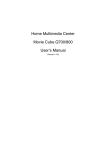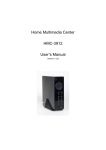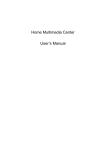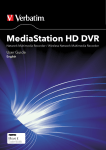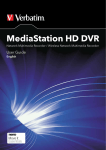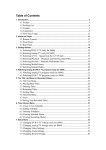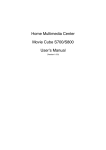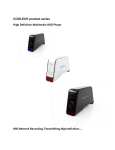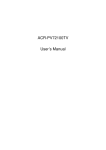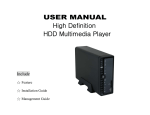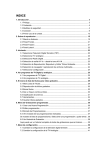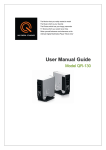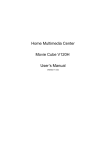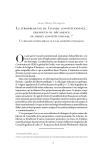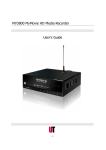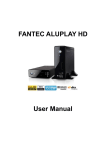Download Table of Contents - produktinfo.conrad.com
Transcript
Table of Contents 1. Introduction..................................................................3 1.1 Preface............................................................................................3 1.2 Packing List....................................................................................4 1.3 Caution...........................................................................................5 1.4 Connection.....................................................................................7 1.5 First Time Usage...........................................................................11 2. About the Player..........................................................12 2.1 Remote Control..............................................................................12 2.2 Front Panel.....................................................................................15 2.3 Rear Panel......................................................................................16 3. Getting Started............................................................16 3.1 Selecting Video In – Live TV, Recording and Time Shift..............17 3.2 Selecting Playback – Playback and Edit Recorded Titles............17 3.3 Selecting Browser – Playback Multimedia Files...........................17 3.4 Selecting Setup...............................................................................17 3.5 Selecting Playlist – Music Playlist..................................................17 4. The Title List Menu for Recorded Videos................18 4.1 Title List Menu.................................................................................18 4.2 Playing Back Titles..........................................................................19 4.3 Deleting Titles..................................................................................19 4.4 Renaming Titles...............................................................................20 4.5 Sorting Files.....................................................................................20 4.6 Title Edit Menu.................................................................................21 4.7 Tools.................................................................................................25 4.8 Saving Your Recorded Titles...........................................................25 5. Timer Record Menu...................................................25 5.1 Create a New Schedule....................................................................25 5.2 Editing Schedule...............................................................................27 5.3 Deleting Schedules...........................................................................27 5.4 Viewing Schedule Status..................................................................28 5.5 Viewing Recording History................................................................28 6. Setup Menu................................................................29 6.1 Changing Language Settings.......................................................29 6.2 Changing Audio Settings..............................................................30 6.3 Changing Video Settings..............................................................31 6.4 Changing Record Settings............................................................33 6.5 Changing Network Settings..........................................................34 6.6 Changing System Settings............................................................35 6.7 Miscellaneous................................................................................36 7. Browser Menu............................................................36 7.1 Browsing All....................................................................................37 7.2 Browsing Music..............................................................................37 7.3 Browsing Photos............................................................................38 7.4 Browsing Movies............................................................................39 7.5 Browsing via Network....................................................................40 8. Playlist Menu..............................................................44 9. File Copy Menu..........................................................44 10. NAS Function...........................................................47 11. Firmware Installation and Upgrade........................48 11.1 Firmware Installation....................................................................48 11.2 Firmware Upgrade.......................................................................49 12. Appendixes...............................................................52 12.1 Specifications...............................................................................52 12.2 Frequently Asked Questions.......................................................54 12.3 Copyrights and Trademarks........................................................58 12.4 Warranty.......................................................................................58 1. Introduction 1.1 Preface Dear Customer, Thank you very much for purchasing the Movie Cube-R700. In the digital era, this product is a great home entertainment partner. With the outstanding brushed aluminum design, you can enjoy movies and music, view photos of precious moments, and record your favorite TV or movie program and view them in your own time. The editing function provides you with an easy way to save these. It’s easy to use this product as a portable external storage device with its built-in HDD and highspeed USB 2.0. This player has the following functionality: Video Recording - sup p o r t s o n e b u t to n r e c o r di n g an d s c h e dul e recording in MPG format, can easily record programs from TV, DVD player and DV, and save as MPEG-2 (.mpg) format; also can edit the recorded titles; - Time shifting function; Movie Playback - supports VOB (DVD), IFO (DVD), MPG (MPEG-2/1), AVI (MPEG-4 ASP: XviD), DAT (VCD), and MPEG-2 TS files; resolution up to 1080i; Music Playback - supports MP3, OGG, and WMA* files; - supports one button playlist music playback; Photo Playback - supports digital camera JPEG, and BMP files; Data Storage - works as a portable hard disk using USB 2.0 port; Network Function - Ethernet & WLAN streaming playback and NAS function (Wireless function supported by the optional Wireless LAN USB Adapter); HDMI - High-Definition Multimedia Interface transmits the highest quality digital video and audio via a single cable, simplifies cabling and provides high quality home theater experience. We hope that this product will bring you a lot of enjoyment. We are committed to apply multimedia technology in your work, entertainment, family, daily life, car and everywhere! Welcome to EMTEC. Thank you again for choosing our Movie Cube-R700. 1.2 Packing List For Worldwide (except USA): Part Quantity Player 1 Cradle 1 A/V IN cable 1 A/V OUT cable 1 Y/Pb/Pr OUT cable 1 SCART cable 1 USB cable 1 Remote Control 1 Remote Control Battery 2 AC/DC adaptor 1 AC/DC adaptor Power Cord 1 User Manual 1 Quick Installation Guide 1 CD (with manuals) 1 Technical support card 1 Wireless LAN USB Adapter 1 (optional) Note: The actual contents in the package might be different from the packing list in this manual. For USA: Part Quantity Player 1 Cradle 1 A/V IN cable 1 A/V OUT cable 1 Y/Pb/Pr OUT cable 1 HDMI cable 1 USB cable 1 Remote Control 1 Remote Control Battery 2 AC/DC adaptor 1 AC/DC adaptor Power Cord 1 User Manual 1 Quick Installation Guide 1 CD (with manuals) 1 Technical support card 1 Wireless LAN USB Adapter 1 (optional) Note: The actual contents in the package might be different from the packing list in this manual. 1.3 Caution This player’s design and manufacture has your safety in mind. In order to safely and effectively use this player, please read the following before usage. 1.3.1 Usage cautions User should not modify this player. If commercial hard disk is being used, the environmental temperature should be within +5°C~ +35°C. 1.3.2 Power The player’s power voltage: DC 12V. When using this player, please connect the supplied AC adapter or AC adapter cable to the player’s power jack. When placing the adapter cable, make sure it can not get damaged or be subject to pressure. To reduce the risk of electric shock, unplug the adapter first before cleaning it. Never connect the adapter to the player in a humid or dusty area. Do not replace the adapter or cable’s wire or connector. 1.3.3 Radio interference/compatibility - If not properly shielded, almost all electronic devices will get radio interference. Under some conditions, your player might get interference. - The design of this player has followed the FCC/CE standard, and has followed the following rules: (1) This player may not cause harmful interference; (2) This player could accept some interference received including interference that may cause undesired operation. 1.3.4 Repair If the player has a problem, you should take it to an appointed repair center and let the specialists do the repair, never repair the player yourself, you might damage the player or endanger yourself or your data. 1.3.5 Disposing of the player When you dispose of the player, be sure to dispose it appropriately. Some countries may regulate disposal of electrical device, please consult with your local authority. 1.3.6 Hard disk cautions The player uses an internal hard disk for data storage, in normal case, format or repair is not required. You should carefully read the < Frequently Asked Questions > chapter, and check our website for latest information before formatting the hard disk. - Physical impact may create bad sector in the hard disk, you can use CHKDSK to fix the problem. - All data stored in the player may be lost due to physical impact, electrical shock, power lost, HDD format etc. Please backup your data. - It is suggested to do defragment after a long period of usage. - Regularly backup the data in the hard disk so that it can be recovered in the event of data corruption or loss. Our company takes no responsibility for loss of data stored on the hard disk. 1.3.7 Others When using this player, please do not let the player come into contact with water or other liquid, if water is accidentally spilled on the player, please use a dry cloth to absorb the spillage. Electronic products are vulnerable, when using please avoid shaking or hitting the player, and do not press the buttons too hard. - Do not let the player come into contact with water or other liquid. - Do not disassemble the player, repair the player or change the design of the player, any damage done will not be included in the repair policy. - Do not press the buttons of the player too hard. - Avoid hitting the player with hard object, avoid shaking the player, and stay away from magnetic fields. - During electrostatic discharge and the strong electromagnetic field, the product will malfunction, then unplug the power cable and the product will return to normal performance next time it is powered on. 1.4 Connection 1.4.1 Connect to Computer (1) Make sure the player is powered on; (2) Plug in the mini connector of the USB cable to this player’s USB DEVICE port; (3) Plug in the big connector of the USB cable to Computer. 1.4.2 USB Mass Storage Device (like U disk, MP3, USB HDD etc.) Connection (1) Make sure the player is powered on; (2) Plug in the U disk or USB HDD etc. to one of the USB host ports of this player. 1.4.3 TV connection 1. A/V IN (1) Follow the picture and plug in the 3 color connector to the player’s A/V IN jack; (2) Follow the picture and plug in the 3 color connector to the A/V OUT jack of the TV/IPTV Set-Top Box (STB). In this way, you can record TV programs from the TV/IPTV Set-Top Box. 2. A/V OUT (1) Follow the picture and plug in the 3 color connector to the player’s A/V OUT jack; (2) Follow the picture and plug in the 3 color connector to the TV’s A/V IN jack. In this way, you can enjoy the content in the player on TV or other display devices. 3. Y/Pb/Pr Component OUT (1) Follow the picture and plug in the 3 color connector to the player’s Y/Pb/Pr jack; (2) Follow the picture and plug in the 3 color connector to the TV’s Y/Pb/Pr jack. Audio Connection while using Y/Pb/Pr Video out: First method: use the audio output from the A/V OUT jack; Second method: use the audio output from the S/PDIF Coaxial or Optical jack. In this way, you can also enjoy videos, music, and photos in the player on TV. 4. HDMI OUT (1) Follow the picture and plug one connector on your HDMI cable to the player’s HDMI jack; (2) Follow the picture and plug the other connector on your HDMI cable to the TV’s HDMI jack. In this way, you can have the highest quality video and audio via a single cable. 1.4.4 Digital Audio Device connection (1) Follow the picture and plug in the RCA connector on your coaxial cable to the player’s S/PDIF Coaxial jack. Or if you use optical fiber, please plug in the Toslink connector on your optical fiber to the player’s S/PDIF Optical jack;(not supplied) (2) Follow the picture and plug in the other connector on your coaxial cable or optical fiber to the digital audio device.(not supplied) 1.4.5 Power connection (1) Follow the picture and connect the AC adaptor to the player’s DC IN jack; (2) Follow the picture and plug in the AC adaptor to the power outlet. 1.4.6 Ethernet connection To connect to a LAN (Local Area Network) you require a cat5, cat5e or cat6 network cable (not supplied). (1) Connect one of the crystal plugs on the cable to the player’s RJ45 LAN socket; (2) Connect the other crystal plug on the cable to a RJ45 LAN port on your router, switch, or hub devices. 1.4.7 WLAN connection (1) Make sure the player is powered on; (2) Plug the Wireless LAN USB Adapter (i.e. Wi-Fi USB Dongle) to the USB HOST port of the player. 10 1.5 First Time Usage 1.5.1 Firmware Installation For users who bought the player without a HDD inside, and want to install a SATA HDD, please see 11.1 Firmware Installation for details. 1.5.2 Remote Control First time usage of Remote control Install the batteries before using the remote control, installation steps are as the picture shows: 1.5.3 Power on/off, language control 1. Power on After connecting the power supply cord, the player will soon enter standby mode, and the red STANDBY indicator on the front panel will turn on. Then press the STANDBY button on the front panel or remote control to wake up the system, wait for a couple of seconds to enter the system and the blue ON indicator on the front panel will turn on. 11 2. About the Player 2.1 Remote Control All procedures in this manual can be carried out using the remote control buttons. Certain functions can also be carried out using the front panel. See the following for details on each button and its function: 1. STANDBY 2. DISPLAY 3. MENU 4. MUSIC 5. TV SYSTEM 6. A-B 7. GUIDE 8. ENTER 9. Numeric buttons10. SUBTITLE 11. AUDIO 12. PLAY 13. FR 14. PAUSE/STEP 15. FF 16. INS REPLAY 17. CM SKIP 18. NEXT 19. SLOW 20. PREV 21. STOP 22. GOTO 23. Navigation buttons 24. RETURN 25. VOL+ 26. VOL- 27. ZOOM 28. REPEAT 29. MUTE 30. SETUP 12 No. 1 Button Function STANDBY button: Press to enter standby mode or wake up. DISPLAY button: 2 Press during playback and an onscreen display appears, showing track number and time elapsed/remaining. MENU button: Press to activate tools menu. • Press during video playback to set bookmark in the popup 3 menu. • Press in the Browser Menu to rename and delete files, or add music to playlists. • Press in My_Shortcuts in NET of the Browser Menu to add shortcuts for network access. MUSIC button: 4 Press the but ton to star t playback music in the f irst nonempty playlist. Press the button again to switch to the next playlist and playback music. TV SYSTEM button: 5 Press to switch between NTSC, PAL, 480P, 576P, 720P, and 1080i. A-B button: 6 Press to set the beginning and end points of a section to repeat. 7 8 9 10 11 12 GUIDE button: Press to view the Guide menu. ENTER button: Press to select options in menus. Numeric buttons: Press to enter numeric input when changing settings. SUBTITLE button: Press to set subtitle options. AUDIO button: Press to select an audio track. PLAY button: Press to begin playback. 13 FAST REWIND button: 13 Press to fast rewind the current playback. Press repeatedly to select speeds. PAUSE / STEP button: 14 Press to pause current playback. Press again to step to the next frame. Press to resume playback. FAST FORWARD button: 15 Press to fast forward the current playback. Press repeatedly to select speeds. INSTANT REPLAY button. 16 Press to backward 10 seconds of the current playback, which suitable for sport program. 17 18 CM SKIP button: Press to advance 30 seconds when in playback mode. NEXT button: Press to go the next chapter on a title. SLOW MOTION button: 19 Press to play back in slow motion. Three motion settings are available. Press 20 21 to resume regular playback. PREVIOUS button: Press to go the previous chapter on a title. STOP button: Press to stop playback. GOTO button: 22 Press to jump to a specific point on a title. Specify the point using Title, Chapter and Time. 23 Navigational buttons: Press the arrow buttons to select menu options. RETURN button: 24 Press to return to the previous screen when navigating menus. 25 14 VOL+ button: Press to increase the volume. VOL- button: 26 Press to decrease the volume. ZOOM button: 27 Press to zoom in/out the image (photo or video). REPEAT 1/ALL button: 28 Press to set repeat options. MUTE button: 29 Press to mute audio output, and press again to resume. SETUP button: 30 Press to access the Setup menu directly 2.2 Front Panel No Name nfrared 1 receiver window 2 3 4 5 6 STANDBY Function Receiving IR signals from the remote control. Indicator (red) turns on when indicator ON the system is in standby mode. I n di c ato r ( b l u e) t u r n s o n indicator MUSIC when the system is alive. I n di c ato r ( b l u e) t u r n s o n indicator REC during music playback. Indicator (red) turns on when indicator recording starts. STANDBY Press to enter standby mode button or wake up. 15 2.3 Rear Panel 1. Air Flow hole 2. V1: Video IN jack 3. L1: Audio IN jack (Left Channel) 4. V2: Video OUT jack 5. L2: Audio OUT jack (Left Channel) 6. Y/Pb/Pr OUT jack (Components Video) 7. HDMI jack 8. RJ45 LAN socket 9. S/PDIF Coaxial jack 10. DC IN jack 11. S/PDIF Optical jack 12. USB HOST port x 2 13. R2: Audio OUT jack (Right Channel) 14. R1: Audio IN jack (Right Channel) 15. USB SLAVE port (MINI B) 3. Getting Started Power on the system, and after a few seconds, the system will enter a guide menu. To return to this menu, press 16 on the remote control too. 3.1 Selecting Video In – Live TV, Recording and Time Shift To pre-view the video to be recorded, or have time shift function (See TIME SHIFT button in 2.1 Remote Control for more details). To select an input source, press on the remote control or select Video In button on the guide menu page. 3.2 Selecting Playback – Playback and Edit Recorded Titles A clip recorded in HDD or USB device is called a Title. Playback the recorded video, you can also Merge/Split/Delete/Edit all the recorded video titles. Press on the remote control or select Playback button on the guide menu page to access Title List. 3.3 Selecting Browser – Playback Multimedia Files You can browse all the multimedia (Videos/ Music/Photos) files on the internal HDD/USB/Card/ or Network and playback them on TV. Press on the remote control or select Browser button on the guide menu page to browser movie, photo, and music files stored either on a HDD, USB device, Memory Card, or Network. 3.4 Selecting Setup To enter the setup menu, select on the guide menu page. on the remote control or select Setup button 3.5 Selecting Playlist – Music Playlist To enter the music playlist menu, select Playlist button on the guide menu page. 17 4.Title List Menu for Recorded Videos The Title List menu allows you to play and edit all saved titles. To enter the menu, press to enter Title List. To select Playback from the Guide menu will enter the Title List also. 4.1 Title List Menu Number 1 Function Description Menu Bar Press or to scroll through the menu. Here you can Play / Delete / Rename / Sort / Edit a recorded title. Here lists all recorded titles. Here you can see thumbnail / length / quality / recorded channel / 2 Title Lists recorded date & time of a title. A sign shows this recorded title has not been watched. A sign shows this title is been recording now. Here you can see a playback progress bar of a 3 Information title, the remained free space of HDD, and remained recording time of each quality. 18 4 Preview Shows the preview window. 4.2 Playing Back Titles To play a recorded title, do the following: 1. Press 2. Press and on the remote control to select the Play tab from the menu bar. and on the remote control to select the title you wish to play. 3. Press on the remote control or the ENTER (Play) button on the front panel to play the file. 4. Press on the remote control or the CANCEL (Stop) button on the front panel to stop playback and return to the Title List menu screen. 4.3 Deleting Titles To delete a title, do the following: 1. Press bar. 2. Press and on the remote control to select the Delete tab from the menu and on the remote control to select the title you wish to delete. 3. Press to confirm and delete the file. 4. A confirmation message appears. Press 5. Press or and select OK. to delete the selected file. To cancel delete, select Return. 19 4.4 Renaming Titles To rename a title, do the following: 1. Press bar. and 2. Press on the remote control to select the Rename tab from the menu and on the remote control to select the file you wish to rename. 3. Press on the remote control. The name entry screen appears. 4. Use the navigation arrows to select letters and numbers. Select CAPS to toggle between uppercase and lowercase letters. Press <- to delete a letter. Press -> to insert a space. Press to input each letter or number. 5. Once you have entered the new name, select OK and press changes. to confirm all If you want to cancel the naming during the process, press 4.5 Sorting Files Press Press 20 and on the remote control to select the Sorting tab from the menu bar. , and the menu appears. Return Select to return to the main screen. Title Number Recording Time Titles Select to sort all files according to the length of the recordings Title Name Fresh Select to sort all files according to title numbers. Select to sort all files alphabetically, according to title name. Select to sort all files according to freshness (i.e. the most recent recordings), listing the most recent recording first. 4.6 Title Edit Menu Press bar. Press and on the remote control to select the Title Edit tab from the menu , and the menu appears. 21 Return Select to return to the main screen. Select to change a thumbnail of the selected video. Press or on the remote control to select Set Thumbnail, an editing screen appears. You can press or to fast forward or fast rewind when searching a proper point. When you reach the point at which you wish to insert Set Thumbnail 22 a thumbnail, press or to select CONFIRM and press . Delete a specified clip in a title. AB Erase Select SET A and press to mark the start for the section to be deleted. Select SET B and press to mark the end of the section to be deleted. Select CONFIRM and press to delete the section. Select a title and divide them into sections. When you reach the point at which you wish to split the track, press to confirm. Split Title Select more than two titles and combine them into one title. A confirmation message appears. Select CONFIRM to merge the files. Merge Title 23 Add a chapter mark to the selected file. A chapter mark is a marker inserted into the title. You can jump between marked sections by pressing the remote control. or on An editing screen appears. When you reach the point at Add which you wish to add the mark, press to confirm. Chapter Mark Remove a chapter mark that you have inserted. An editing screen appears. Use the left and right navigation arrows to select the mark you wish to remove and press to delete. Remove Chapter Mark Copy to FAT32 partition 24 Copy function. In the Title List Menu, press or on the remote control to select which title you want to copy from UDF partition to FAT32 partition. 4.7 Tools Press and on the remote control to select the Title Edit tab from the menu bar. Press and the menu appears. Return Delete All Title Select to return to the main screen. Select to delete all titles. 4.8 Saving Your Recorded Titles All the recorded titles are stored temporarily in a recording disc partition (UDF format) which cannot be identified by personal computers. If you want to share the recorded titles on your computer, please copy the titles from the recording disc to the multimedia disc which is in FAT32 format first. See Copy to FAT32 partition in 4.6 Title Edit Menu for more details. 5. Timer Record Menu The Timer Record menu allows you to create, edit and delete recording schedules and view all schedule status and history. Press control to enter the menu. on the remote 5.1 Create a New Schedule Press and on the remote control to select the Edit tab from the menu bar. 25 Select Add a New Schedule and press appears. Use . The schedule setting screen and on the remote control to move between fields and Press to adjust each setting. Start Time Enter the date and time of the recording. Length Enter the length of the recording and Select how often you want the schedule to record. Repeat Choose from Once, Everyday, Mon-Fri, Mon-Sat or for an individual day of the week. Select the recording quality. Choose from HQ, SLP, EP, LP and SP. Quality The higher the quality, the more space required on the hard drive. See HDD Free Space on the left of the screen for details of how long you can record for using each setting. 26 This small preview window will show the current program Preview of the select channel. 5.2 Editing Schedule Press and on the remote control to select the Edit tab from the menu bar. Select the schedule you want to edit from the list and press . The schedule setting screen appears. Modify the schedule as described in 5.1 Creating a New Schedule. 5.3 Deleting Schedules Press and on the remote control to select the Delete tab from the menu bar. Select the schedule you want to delete and press appears. . A confirmation message Select CANCEL, Delete the selected schedule or Delete all schedules. Press to confirm. 27 5.4 Viewing Schedule Status Press and on the remote control to select the Status tab from the menu bar. The schedule list is displayed. Select a schedule and press . Select Enable VPS, Disable VPS or Pause the selected schedule. Press confirm. to 5.5 Viewing Recording History Press and on the remote control to select the History tab from the menu bar. Here you can view a complete history of all recordings that were set. 28 6. Setup Menu The Setup Menu allows you to configure language, audio, video, record, network and system settings. To enter the menu, select Setup from the Guide menu or select on the remote control. 6.1 Changing Language Settings Press bar. and on the remote control to select the Language tab from the menu Select to choose the OSD (On Screen Display) language. Menu Language Press and to select the language. Press confirm. to Select to set text encoding. Text Encoding Press and to select from Unicode, Chinese GBK and BIG5. Press to confirm. 29 6.2 Changing Audio Settings Press and on the remote control to select the Audio tab from the menu bar. Select to set night mode. Night Mode Press and to select from Off, On, and Comfort. Press to confirm. Select to set S/PDIF mode. S/PDIF Press and to select from Raw, and LPCM. Press to confirm. 30 6.3 Changing Video Settings Press and on the remote control to select the Video tab from the menu bar. Select to set aspect ratio. Press and to select from Pan Scan 4:3, Letter Box 4:3, or 16:9. Press to confirm. Pan Scan 4:3: Display a wide picture on the entire screen and cuts off the redundant portions. Aspect Ratio Select when a standard 4:3 TV is connected. Letter Box 4:3: Display a wide picture with two black borders on the top and bottom of 4:3 screen. Select when a standard 4:3 TV is connected. 16:9: Compress the image to convert the whole image. Select when a 16:9 TV is connected. 31 Select to set brightness levels. Brightness Press and to adjust brightness. The new setting is previewed onscreen. Press to confirm. Select to set contrast levels. Contrast Press and to adjust contrast. The new setting is previewed onscreen. Press to confirm. Select to adjust video output type. Video Output Press and to set the video output type, depending on your viewing preferences. Press to confirm. Select to adjust TV system. Video System Press and to set the TV system, depending on your viewing preferences. Press to confirm. 32 6.4 Changing Record Settings Press and on the remote control to select the Record tab from the menu bar. Select to set the default recording quality setting. Press and to select the quality setting you require. Quality The highest quality setting is HQ which requires the most storage space. The other settings reduce recording quality sequentially but also require less storage space. Press to confirm. S elec t to add c hapter mar ks automatically at set intervals. Press and to Auto select the interval you require. An Chapter automatic chapter mark will be added at each interval, allowing yo u b r o w s e t i t l e s e a s i l y a f t e r recording. Press to confirm. 33 Select to set Time Shift mode. Permanent Timeshift Press and to select from On and O f f. Press to confirm. If On, the Time S h i f t f un c t i o n w i l l b e a c t i vate permanently. Select to set device to restore the recorded files. Record Device Press and to select from HDD and USB. Press to confirm. Select to set Time Shift device. Timeshift Device Press and to select from HDD, USB, and Auto. Press to confirm. 6.5 Changing Network Settings Press bar. 34 and on the remote control to select the Network tab from the menu Please refer to the user’s guide to wireless function in the package of EMTEC Wi200 USB adapter for more details about these settings. 6.6 Changing System Settings Press and on the remote control to select the System tab from the menu. Select to set the system time. Press setup. and enter Manual Time Enter the system menu and press and to select each field and the up and down navigation arrows to adjust each setting. Press to confirm. 35 Select to restore factory defaults. Restore A confirmation message Default appears. Select OK and press Enter to restore all settings to defaults. 6.7 Miscellaneous Press and on the remote control to select the MISC tab from the menu. 7. Browser Menu The Browser menu allows you to browse and play music, photo and movie files stored on a HDD, an external USB device, Memory Card, and Network. To enter the menu, select Browser from the Guide menu. 36 Press and to select the device on which the media is stored. Choose from HDD, USB, CARD, NET and press . When data on HDD, USB device and Memory Card is connected or connect the system to Network, you can also browse photos, listen to music, and watch movies. 7.1 Browsing All Use and on the remote control to select the All tab. All directories and supported contents will be displayed. Press to select the directory or file you wish to browse, and press and to confirm. 37 7.2 Browsing Music Use and Press on the remote control to select the Music tab. and to select the folder that contains your audio files. A thumbnail strip appears at the bottom of the screen, along with song information. Press and Press to select the file you want to play and press . and a tools menu appears which enables you to add the current music to the playlists. 7.3 Browsing Photos Use 38 and on the remote control to select the Photos tab. Press and to select the folder containing your photo files. A thumbnail strip appears at the bottom of the screen, along with a preview of the selected photo. Press and to select the photo you want to view and press photo will be displayed full screen. . The Note: 1. When the photo is displayed in full screen mode, the slide show starts automatically. 2. While listening to music files, you can browse the photos at the same time. While browsing a photo, you can press Besides rotating a photo, you can press or to rotate a photo in any angle. to zoom in/out that photo. Three zoom levels are available. 7.4 Browsing Movies Use the left and right navigation arrows to select the Movies tab. 39 Press and to select the folder that contains your movie files. A thumbnail strip appears at the bottom of the screen, and a preview of the selected movie will be played. Press and to select the movie you want to view and press will be played in full screen mode. . The movie This browsing movies function supports DAT, VOB, IFO, MPG, AVI, and TS file formats. While browsing a movie in full screen mode, you can press the image. Four zoom levels are available. to zoom in/out 7.5 Browsing via Network You can streaming playback the multimedia files shared on the local area network (Ethernet or WLAN). Before viewing the following, please make sure that you have read 4.4 Changing Network Settings and made the right settings. When selecting NET in the Browser menu, there are two ways to locate the multimedia files shared on your local network. One way is to browse through workgroup; the other way is to browse through ‘My_Shortcuts’. 40 7.5.1 Browsing through Workgroup You can choose the workgroup which your PC belongs to from the workgroup list, find your PC name, and press to confirm. Then select the shared multimedia file that you want to browse. 41 Note: Due to different network conditions, sometimes the workgroup might not be accessed or shown in the list. And then you need to use ‘My Shortcuts’ to browse shared files. 7.5.2 Browsing through ‘My Shortcuts’ You can also set ‘Specific File Server IP’ and access it from ‘My Shortcuts’ in the menu. Press and a tools menu appears. Select to set Net User ID, Net Password, and Specific File Server IP, which enables to browse files on NET through ‘My_Shortcuts’. Network Browser Select Net User ID and the entry screen will appear. Use the navigation ar rows to select letters and numbers. Select CAPS to toggle between uppercase and lowercase letters. Press <- to delete a letter. Press -> to insert a space. Press letter or number. 42 to input each Select Net Password and the e nt r y s c r e e n w ill ap p e ar. S e e above. Select Specific File Server IP, Network and use Navigational and Numeric Browser buttons to enter IP address. You can also select Detail to set the Label, Domain, and Host Name of the shortcut. Then select OK and press Select the shortcut you added and press to confirm. to confirm. Then select the shared multimedia file that you want to browse. 43 8. Playlist Menu The Playlist menu allows you to browse and play your favorite music in the playlists. To enter the menu, select Playlist from the Guide menu. There are up to 5 playlists. 9. File Copy Menu Press on the remote control to enter the File Copy menu, which allows you to copy files between HDD and USB devices. 44 Step 1: Select the source device and destination device. Press and to select device. Press to cancel, and for next step. Step 2: Select the source files you want to copy. Press to select files, to cancel, and to next step. Step 3: Select the destination folder to store the above files. 45 Press and to select folder. Press to cancel, and for next step. Step 4: Proceed to copy selected files. Press start. 46 and to select OK, press to confirm. And the copy will 10. NAS Function This player can be used as a NAS (Network-Attached Storage) device. It can be attached to the home network via either Ethernet or WLAN. This feature allows homes to store and retrieve large amounts of data more affordably than ever before. When the network connection is done correctly and ready for use, type: \\NAS or \\IP Address in the Run window (click Run in the start menu) or the address bar of Internet Explorer on your PC (For example, if the IP address of the player is 192.168.0.9, please type: \\192.168.0.9 or \\NAS), and click OK or press the Enter button on the keyboard. Then you can view, and edit the files stored on the hard disk installed on the player. In this way, you can also playback and copy files via network between your PC and the player. Note: Partitions of NTFS file system format on the hard disc drive will be readonly. 47 11. Firmware Installation and Update The firmware is the operating system (OS) installed on the device. 11.1 Firmware Installation If it is the first time that you are installing a SATA HDD (no matter it is a new one or an old one) into the player, please make sure you have read the following steps in advance. Step 1: Backup Data Please backup the data in the HDD before installing it into the player. The following steps will format the hard disc, which will erase all data currently stored on the hard disc. Step 2: Install the HDD Follow the HDD Installation Guide, and install the HDD into the player. Step 3: Prepare the USB Pen Drive You will need a USB Pen Drive for firmware installation. Copy the 6 files from the firmware folder to the root directory of your USB Pen Drive. Step 4: Connect the USB Pen Drive Plug the USB Pen Drive into one of the USB HOST ports of the player. Step 5: Hold the STANDBY button Press and hold the STANDBY button on the front panel, and do not loosen. 48 Step 6: Connect the power cable Plug the power cable into the DC IN jack, wait for about 3 seconds or more, and then loosen your finger on the STANDBY button; Firmware installation will start in about 30 seconds. The LED indicators on the front panel will be enlightened and flashing during installation. If it is connected to a TV set, a yellow install page will appear on the TV screen. Please wait for about 10 minutes, the installation will be completed, the LED indicators will go off, and the player will be powered off automatically. Then you can press the STANDBY button to turn on the player and enjoy. Note: If install error or white screen occurs, please unplug the power cable and try again; Do not turn off the power during installation; The USB Pen Drive is not allowed to be unplugged during installation. 11.2 Firmware Upgrade Firmware upgrades can bring new features, improvements and bug fixes. 49 To check whether you have the latest version of firmware: 1. Select MISC in the Setup menu; 2. The firmware version number is displayed behind SW Version; 3. Compare it with the latest firmware version released. Note: Firmware upgrade will delete all of the recorded titles in the UDF recording partition. Please copy the recorded data to FAT32 partition in your hard disc in advance. See Copy to FAT32 partition in 4.6 Title Edit Menu for more details. Download the latest firmware from our official website. Step 1: Prepare the USB Pen Drive Copy the 6 files into the root directory of your USB Pen Drive. Step 2: Modify ‘part.txt’ Open ‘part.txt’ file in the USB Pen Drive with WordPad, and make sure to modify ‘option:install’ to ‘option:upgrade’. 50 Item Option:install Description This option will perform firmware installation, which will format the whole HDD (All data on the HDD will be removed). option:upgrade This option will perform firmware upgrade (Recording partition will be removed, but multimedia partitions will be kept). Note: Please do not modify the other sentences in ‘part.txt’, which might cause install error. Step 3: Repeat step 4, step 5, and step 6 in 11.1 Firmware Installation. Note: When installation or upgrade is completed, several system partitions would be created. Please do not delete any of these partitions in case of hard disc failure. 51 12. Appendixes 12.1 Specifications USB SUPPORTED: * USB HDD * Other USB Mass Storage Devices * USB 2.0 Interface CONTENT FORMATS SUPPORTED: * DAT/VOB/IFO/MPG/AVI/MPEG-2 TS * MP3/OGG/WMA * Compression rate: between 32 kbps and 320 kbps * JPEG/BMP VIDEO CODECS SURPORTED: * MPEG-1/MPEG-2 * MPEG-4 ASP: XviD AUDIO CODECS SURPORTED: * MP2/MP3 /OGG Vorbis/WMA Standard (DRM, Pro & Advanced Profile not supported)/PCM SUBTITLE FORMATS SURPORTED: * SRT, SMI, SSA, IDX/SUB RECORDABLE DEVICES SUPPORTED: * Built in HDD * USB HDD 52 VIDEO RECORDING MODE Mode 80 GB HDD 120 GB HDD 160 GBHDD 24hrs 33hrs 48hrs 66hrs 48hrs 72hrs 99hrs EP 64hrs 96hrs 132hrs SLP 96hrs 144hrs 198hrs HQ 16hrs SP 32hrs LP VIDEO RECORDING FORMAT * HQ/SP/LP/EP/S-LP mode: MPEG-2 MP@ML AUDIO RECORDING FORMAT * HQ/SP/LP/EP/SLP mode: MP2 2-chanel VIDEO OUTPUT SPECIFICATION Composite Output Components Output 1 Vpp 75 Ohm Y:1 Vpp 75 Ohm Cb:0.7 Vpp 75 Ohm Cr:0.7 Vpp 75 Ohm HDMI Output HDMI (Version 1.1) NETWORK FEATURE Ethernet 10/100Mbps Auto-Negotiation WLAN IEEE 802.11b/g, up to 54Mbps (supported by the optional WLAN USB Adapter) AUDIO PERFORMANCE DA Converter 24-bit/192kHZ AD Converter 24-bit/96kHZ Signal-Noise (1kHZ) Dynamic Range ≥ 95dB ≥90dB (1kHZ) Channel ≥95dB Separation Total Harmonic Distortion (1kHZ) ≤-85dB 53 GENERAL Power Supply Power Consumption Operating Temperature Operating Humidity Hard Disk Dimensions (W/H/D) Net Weight AC 100~240V 50~60Hz Approx. 35 W +5°C to +35°C (+36°F to +95°F) 5% to 80% RH 3.5’’ SATA HDD 203x164.4x53mm (7.99”x6.47”x2.09”) Approx 1.5 kg Note: The specifications and design of this product are subject to change without notice. 12.2 Frequently Asked Questions Question 1. My computer does not recognize my player. Answer: (1) Make sure the player is powered on. If it is off, the computer will not be able to find the player; (2) Make sure the player is connected to computer. (Refer to 1.4.1 for connecting player to computer); (3) When using Windows 98SE, install the USB driver first. After installation, restart the computer. Then reconnect the player to the computer. (Refer to 1.4.1 for connecting player to computer); (4) If you installed the Windows 98SE driver over your Windows® XP, 2000, or ME edition, problems might occur; (5) It is not recommend using the USB ports in the front of your computer, try to 54 use the USB ports in the rear, because the USB ports in the front are often from non-powered hubs. Question 2. When I try to disconnect the USB device, I keep on getting "The device 'Generic volume' cannot be stopped right now. Try stopping the device again later." message, what should I do? Answer: Close any program that might be accessing data on the player, including Windows ® Explorer. If it does not work, close all programs and wait for another 20 seconds, then try the green arrow icon again. If it still does not work, you should shut down the player and disconnect the USB cable. Question 3. I find new file names and folder names that I never created before or they have strange gibberish names. Answer: Most likely, the player’s file allocation table (FAT) has been corrupted. This might be due to the player shutting down (due to low battery power) while reading or writing to your computer by the USB connection. Windows and Macintosh often write extra files to the hard disk such as finder.def or System volume info. These are normal and will not do any harm to the player. Question 4. I used my player to transfer files back and forth between different computers. Will defragmenting the player hard disk do any harm to it? Answer: Defragmenting the player hard disk may be useful after having transferred many files to and from the player. It is never harmful to use the defragment on the player. Make sure no other programs are running while using the Windows® defragment utility. Make sure you have connected the player with the external power adapter during this procedure. Question 5. My files have disappeared from the player. Answer: Make sure that you browse your files via the correct Browser mode which means correct filtered views such as Photos, Music, or Movies. 55 Question 6. Why do some supported photo formats, cannot be shown in the photo function? Answer: In the JPEG format there are different modes. The player doesn’t support all the modes. So you have to change your photo format first as follow: (1) Use Photoshop to open the photo; (2) Choose ”File” then “save as” from the menu, as the picture on the left hand side shows, select the picture format as JPEG, input the file name and click the “save” icon; (3) After click on the “save” icon, a new window will appear as the picture on the right hand side shows, select “Baseline (standard)” or “Baseline optimized”; (4) Click the “OK” icon. Question 7. During power on, why does the TV will have a short flashing, blue screen or screensaver? Answer: This is normal, when the system initializes, it will setup the corresponding parameters so it can output the correct video signal to the TV, during the initializing time, the TV will receive incorrect signals or the signals will not be stable and will cause the TV screen to flash, some TV’s will treat this as no signal, and will display a blue screen or screensaver. Question 8. Why when I switch to Y/Pb/Pr 480P, 576P, 720P, 1080I, 56 does the TV screen display an unwatchable picture? Answer: Please check if your TV supports Y/Pb/Pr 480P, 576P, 720P, 1080I output, if your TV does not support, please use the A/V signal display instead, press the TV SYSYEM button on the remote control, then switch the TV’s video input to NTSC or PAL. Question 9. Why is there no sound on movie or music playback when using Y/Pb/Pr component output? Answer: Y/Pb/Pr output is a video output only, and does not include sound signals, when using Y/Pb/Pr output, please plug the A/V OUT or the S/PDIF jack to output sound. Question10. Why couldn’t the player find the hard disc? Answer: Make sure the firmware is installed correctly, and no system partitions on the HDD were deleted. If hard disc failure occurs, please backup your data and reinstall the firmware using the Firmware Installer software in the Driver CD which is provided along with the player. Question11. Some functions like recording, time shift etc. do not work. What should I do? Answer: If you find some functions do not work properly on the player, please change system settings to the default (Refer to 6.6 for changing system settings). Question12. While playing movies in the multimedia partition, buttons like PREV, NEXT, A-B, etc. sometimes could not be used. Answer: The above functions are designed for recorded video titles and IFO (DVD) files only. 57 12.3 Copyrights and Trademarks Copyrights All rights reserved. No part of this manual may be reproduced, stored in a retrieval system, or transmitted in any form or by any means, electronic, mechanical, photocopying, recording or otherwise, without the prior written permission from the copyright holder. According to copyright law, no recorded data may be used for purposes other than personal enjoyment without permission from the copyright holder. Trademarks Microsoft and Windows are registered trademarks of Microsoft Corporation. All other trademarks are property of their respective holders. 12.4 Warranty What your warranty does not cover: -Acts of nature, such as fire, static discharge. -Damage from unauthorized repair, alteration or accident. -Damage from misuse or neglect. -A unit that has been modified or incorporated into other products or is used for institutional or other commercial purposes. -Loss of customer’s software, firmware, information, or memory data. -Improper handling or installation. For complete information regarding EMTEC Movie Cube-R warranty and customer support please visit our website : www.emtec-international.com V1.0 58


























































